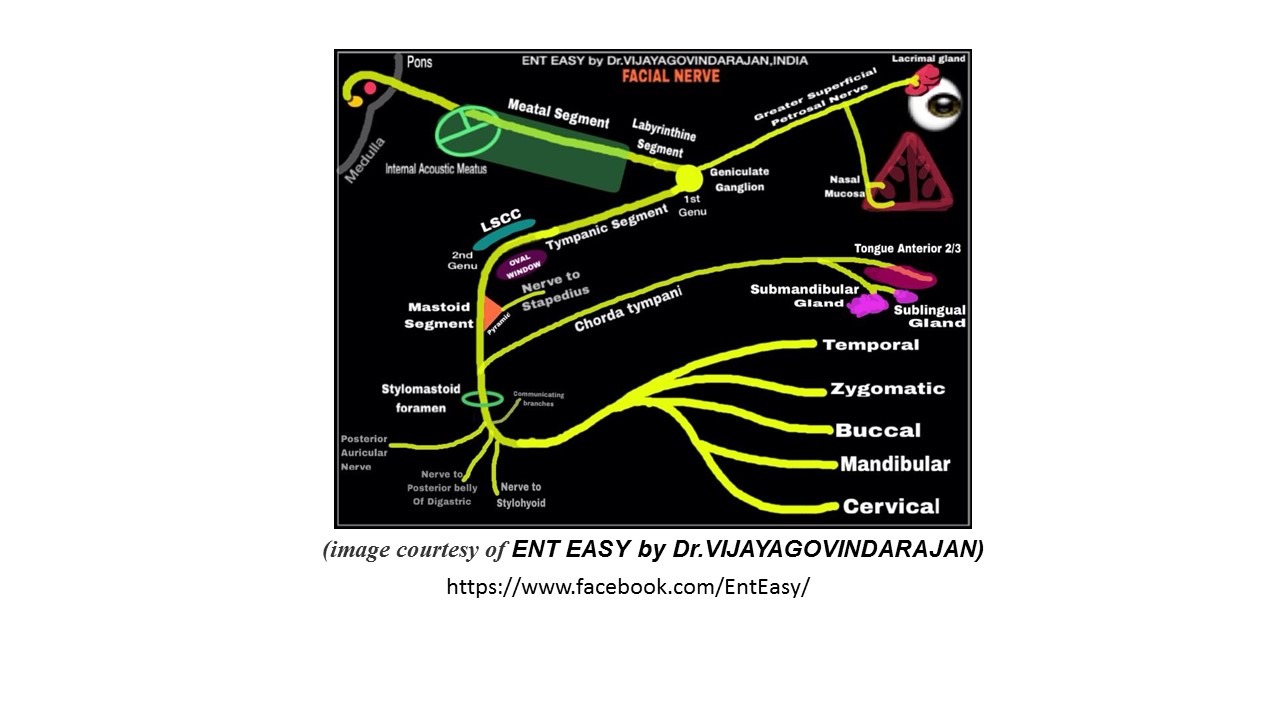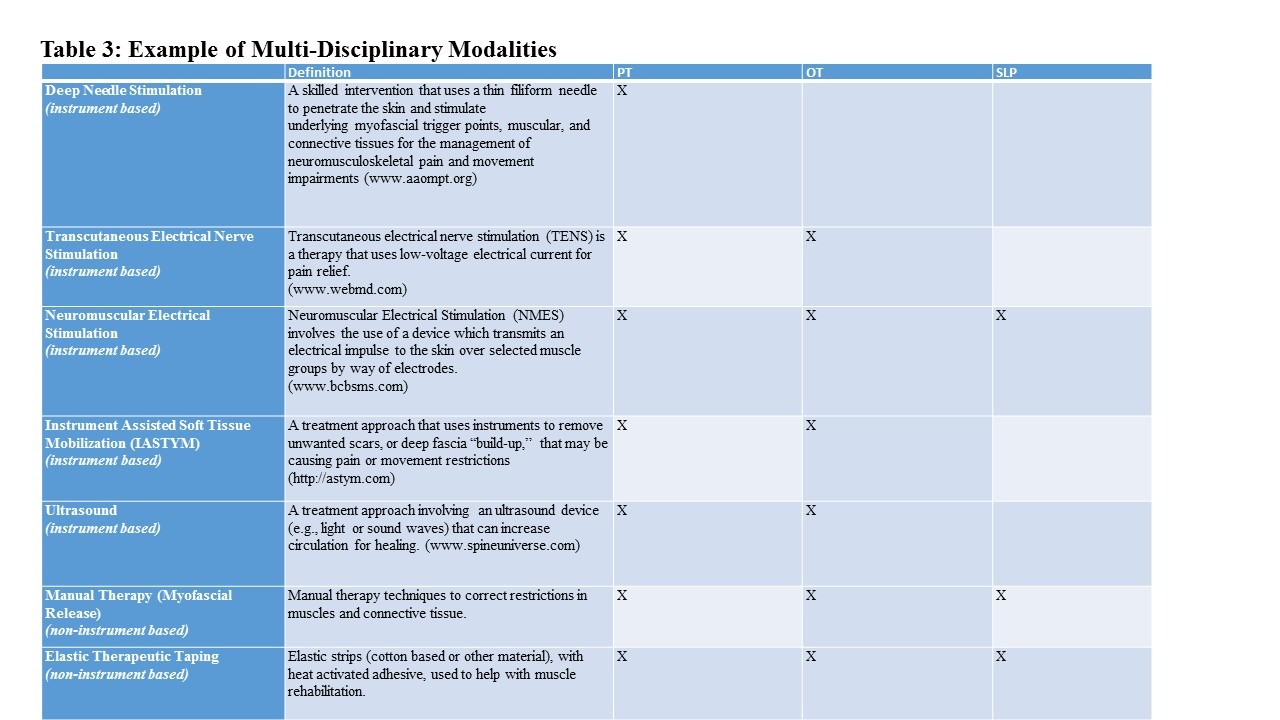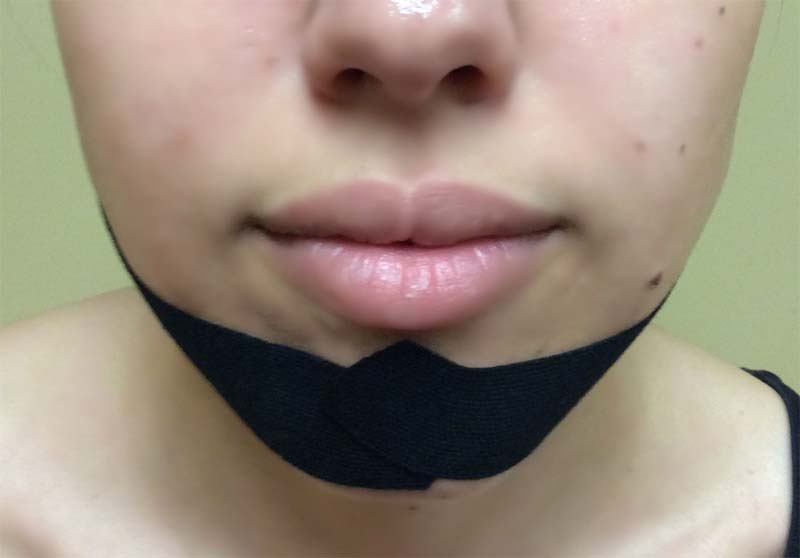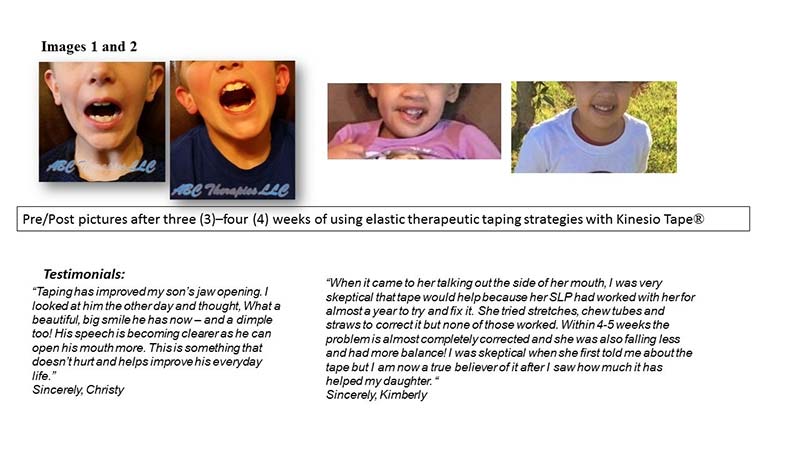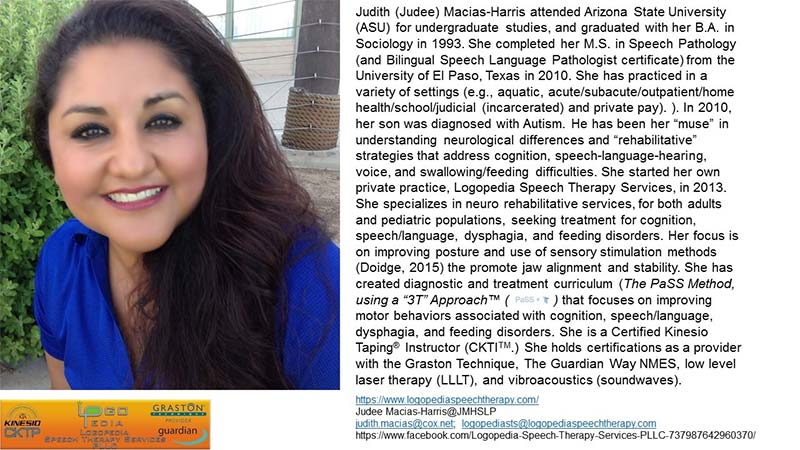Elastic Therapeutic Taping with Kinesio® Tape:
An Adjunct Modality for the SLP
by Guest Bloggers for SwallowStudy.com:
Judith Macias-Harris, M.S., CCC-SLP/BSLP/CKTI
Elizabeth G Harvey, DPT, MSR, CKTP
*******
SwallowStudy.com Disclosures:
Financial Disclosure: SwallowStudy.com has no financial relationship with the organizations mentioned in this article.
Non-Financial Disclosure: SwallowStudy.com is sharing this new modality for educational purposes, to promote discussion, and to suggest further exploration and research. This post does not to indicate endorsement.
*******
Speech Language Pathologist – Who We Are
Per the American Speech and Hearing Association (www.ASHA.org), the speech-language pathologist (SLP) is the professional who engages in clinical services, prevention, advocacy, education, administration, and research in the areas of communication, cognition, voice and feeding/swallowing, across the life span from infancy through geriatrics. The overall objective of speech-language pathology services is to optimize individual’s ability to communicate and swallow, thereby improving quality of life.
Complicated Issues Within the SLP’s Domain
Pediatric and adult populations referred for SLP services present with complicated co-conditions that negatively influence cognition, speech, language, voice, and swallowing (Table 1). Taking these factors into consideration can greatly influence rehabilitation outcomes.
Table 1: Co-Conditions Associated with Speech, Cognition, Language, Voice, and Swallowing Deficits
Co-Conditions |
Possible Causes of Co-Conditions |
|
|
The SLP’s Toolbox: Conventional vs. Rehabilitative Strategies
Traditionally, the SLP’s toolbox has focused on conventional strategies that may lead to improved muscle coordination and strength, which may transfer to an increased ability to tolerate oral intake (Table 2).
Table 2: Conventional Strategies versus Rehabilitative Strategies
Conventional Strategies |
Rehabilitative Strategies |
|
|
However, labial and lingual control is contingent on jaw alignment and stability. This alignment will be affected by head and trunk control and pelvic stability (Johnson and Gray, 2008; Redstone and West, 2004). Poor alignment and/or motor deviations in the trunk and pelvis can lead to symptoms associated with:
- jaw fixing (lack of fluid mobility between levels of jaw height, affecting speech and swallowing function),
- breathing/swallowing discoordination, and
- aspiration risk (Johnson and Gray, 2008; Redstone and West, 2004).
Rehabilitation methods are interventions that target muscle group deficits to move towards homeostasis, or original state, using some form of stimulus. Interventions target change at the neurovascular or cellular level via stimulation of “light, sound, vibration, movement.” (Doidge, 2015). Oral/pharyngeal muscle group deficits can be affected by spine and upper or lower extremity dysfunctions due to the properties of biotensegrity, which are connectivity and tension relationships throughout the body (Ingber, 2003; Ingber, 2006). The following can be addressed through the rehabilitation process:
- pain,
- inflammation/lymphatic fluid congestion,
- tonic/phasic muscle group relationships,
- fascia restrictions, and
- poor joint biomechanics or alignment.
One way to improve toward rehabilitative homeostasis is to use either non-instrument or instrument-based stimulus methods. Using either method alone or combined, encourages systematic and synergistic tissue, muscle, and/or ligament healing across structures (jaw, head, trunk, and pelvis).
Customary Modalities Used by Allied Healthcare Professionals:
The following table characterizes standard, but not exhaustive, modalities typically used PT’s, OT’s, and SLP’s. (Table 3).
Modalities are necessary to remove resistant forces that prevent the physiology of healing, but they only work as well as the thought process behind them. The rehabilitation occurs when three factors are taken into consideration:
- Clinical analysis,
- Solid diagnostic interpretative skills, and
- Proficient understanding of anatomy/physiology (along with how the body functions as a system).
This triangulation of abilities allows the treating clinician to assess and interpret how “the hierarchy” of systems (skin, circulation, fascia, autonomic nervous system) may be affecting muscles and joint deficits wherever they are occurring in the body (Barnes, 2011; Spencer, 2015). Once this has been established, then any modality (standalone or multi-modal) can be used more effectively for rehabilitative purposes.
It is all about the jaw!
The SLP’s areas of treatment present the need to affect muscle group tensegrity in the head/cervical/thoracic/pelvic areas for one reason –> jaw alignment and stability.
Jaw stability is the foundation for speech production and feeding management (Johnson and Gray, 2008). The jaw, the temporomandibular joint (TMJ), and hyoid bone are suspended structures supported by a series of ligaments, muscles, and cartilages. In order to maintain TMJ/mandibular alignment and stability, cervical and submental muscles must be able to work synergistically with the trunk, pelvis, and extremities.
Traditionally, the focus of strengthening the muscles of the oral cavity has overshadowed the need to keep the TMJ condyle aligned and stable. The oral cavity is intimately affiliated with the temporomandibular joint. Picture a door on a hinge. Trying to strengthen the door, which has come unhinged, will not cause improved function – which is our goal. However, keep the door hinged (aligned and stable), and see the improvement in function. Muscle strength improves by 30% when the joint is stabilized (Kase, 2014). The essence of oral motor exercises (OME), specifically for muscle groups that support the mandible, is beneficial; however, until the muscles, ligaments and tendons that support the TMJ joint are addressed, everything else in the oral cavity (tongue, lips) will be limited in providing the synergistic movement and strength necessary for optimal function.
Along with TMJ joint alignment, overall postural compliance is key to the normal feeding and swallowing process (Redstone and West, 2004). The whole body, with its ascending/descending neural pathways, will impact the synergistic movements associated with swallowing and labial/lingual movement (Gisel et al., 2000; Johnson and Gray, 2008; Redstone and West, 2004).
TMJ/Mandibular Alignment and Stability: How is this related to speech, language, cognition, voice?
The brain is composed of three main structural divisions: the cerebrum, the cerebellum and the brainstem. The cerebellum lies beneath the occipital and temporal lobes; it’s functions are to maintain balance and posture, to promote muscle coordination, motor learning, sensory processing and cognitive functioning.
The reticular activating system (RAS) is a loose network of neurons and neural fibers, consisting of two systems – ascending and descending. (Read More: What is the Reticular Activating System?)
The ascending RAS connects to the cortex, the thalamus, and the hypothalamus.
The descending RAS connects to the cerebellum and to nerves responsible for the various senses.
Information from somatosensory, hearing and vision systems help activate many cortical areas associated with cognitive function (Read More for a “Mind Workout: The Power of Focus and Imagination” on CareerTuneUp.com).
In conjunction with the RAS, the mandible and TMJ joint also bring information to the temporal lobes through the cranial nerves (Schrader et al., 2011). Trigeminal nerve (CNV3 – mandibular branch) stimulation has been shown to have a neural connection to CN VII and VIII at the auditory meatus and TMJ junction thus showing the vast connectivity of the neural network at this site (Ash et al., 1991; Blum; 2008; Buraa, 2013; Faught and Tatum 2013; Finley, 2014; Schrader et al., 2011; Williams, 2015).
Cognitive scientists at Indiana University have also discovered a strong correlation between hand-eye coordination, learning abilities, and social communication skills (See this article by Bergland, C.). Using tactile stimulation techniques in the hand has been shown to stimulate cortical brain activity, possibly due to peripheral innervation through radial, medial, and ulnar nerves which connect at the brachial plexus. There is converging evidence that proprioceptive training of the upper and lower extremities can yield meaningful improvements in somatosensory and sensorimotor function (Aman et al., 2014). Also, the globulus skin of the hands and feet are rich with cutaneous receptors, which have been shown to be more important for reflexive postural responses than vestibular or vision systems (Kafa, 2015).
Modalities and the SLP
Using either non-instrument or instrument-based stimulus methods appears to help rehabilitate muscle group deficits related to speech, language, cognitive, vocal, and swallowing function (Hamdy, 1998; Kelly, 2011, McGough, 2015; Oh et al., 2007).
Body systems (e.g., endogenous analgesic, lymphatic, fascia, muscles, and joints) can be addressed effectively with the use of modalities, such as elastic therapeutic tape. Corrective techniques (e.g., mechanical, fascia, space, ligament, functional, and lymphatic) used appropriately can help with remediation of spine, upper and lower extremity dysfunction that impact jaw alignment and stability.
“Got Tape?”- Elastic therapeutic taping with Kinesio® Tape as an adjunct modality for the SLP
The unique qualities of elastic therapeutic tape, specifically Kinesio® Tape, appear to support the complex role of the SLP in many ways.
First, as a passive modality, it supports the Primum Non Nocere (“First, do no harm“) principle. It is a gentle modality, which can be used to relieve pain, normalize range of motion, improve muscle contraction, stabilize joints, assist in tissue recovery, and release fascia restrictions. Kinesio® Tape’s thickness and weight are similar to skin and act as a stimulus effect to create a cortical response through the RAS. Also, the tape is tolerable for most patient populations, geriatric to pediatric, and can be used at any stage of the rehabilitation process (e.g. acute, sub-acute, and chronic).
Second, one of the most valuable methods of elastic therapeutic taping for the SLP may be in applying tape using E D F [TM] Taping Strategies (E D F for Epidermis, Dermis, Fascia is trademarked). E D F [TM] Taping strategies provide techniques to stimulate the body’s nervous system through the surface of the skin (Kase, 2014).
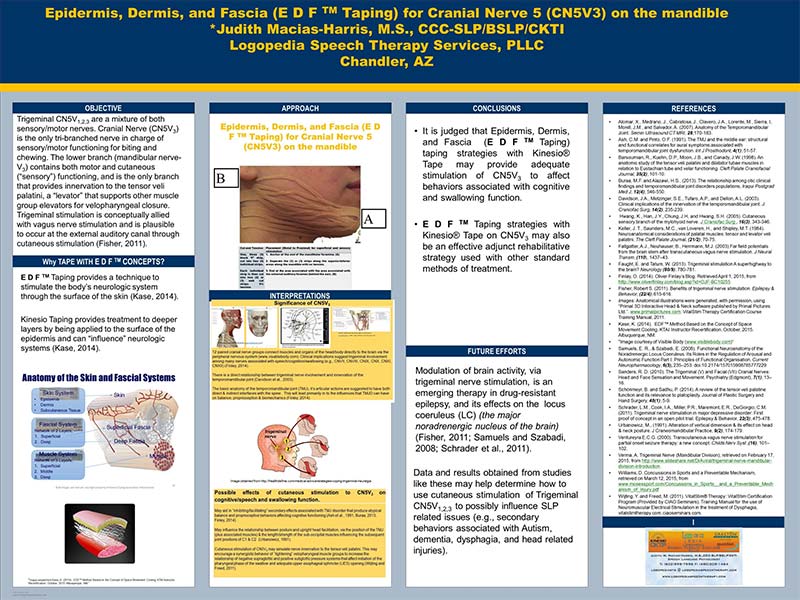
Poster presented at the Kinesio Symposium November, 2015, Japan. Epidermis, Dermis, and Fascia (E D F TM Taping) for Cranial Nerve 5 (CN5V3) on the mandible.
This level of taping suggests minimal tape tensions on the epidermis to affect the underlying connections between fascia, nerves and muscles (Kase, 2014). Dr. Guimberteau’s research has shown that stimulation to the most superficial layers can affect the deeper layers in the body (Guimberteau, 2007; Guimberteau et al., 2010). It appears that this taping strategy may be affecting sensory stimulation and/or fascia patterns to inhibit muscle contractions that affect jaw stability. It may also help improve spinal, upper and lower extremity dysfunction by unwinding fascia to decrease postural contractions. More data may be on the horizon to further describe the relationship of this level of taping on sensory stimulation and areas typically addressed by the SLP’s (e.g., proprioception).
Considering the areas of the brain responsible for sensory processing and executive function, the use of elastic therapeutic tape in these specific methods and locations can evoke great change. Wen et al. (2012) studied the effects of paravertebral fascial massage on brain development, associated with increased levels of IGF-1, in rat pups. His research found statistically significant increases in the areas of the subventricular zone of the lateral ventricles and denate gyrus of the hippocampus (2012). These areas are important for memory, exploration, and is the largest of three sites where neurogenesis occurs (Alvarez-Buylla and Garcia-Verdugo, 2002). Massage of the trunk and extremities in infants has also been shown to cause increases in IGF-1 in circulation and increased maturation of visual function, as compared with control group infants (Guzzetta et al., 2009).
Third, elastic therapeutic taping is a cost-effective modality. It can be used independently or in cohort with other conventional and rehabilitative techniques. Reimbursement options (e.g., CPT code 97533; Sensory integrative techniques to enhance sensory processing and promote adaptive responses to environmental demands) may also be possible.
Presently, there are only three speech language pathologists worldwide at the instructor level for the Kinesio® Taping Method. Many licensed SLP’s, however, have taken the coursework, have become Certified Kinesio® Tape Practitioners (CKTP), and use elastic therapeutic taping as part of their repertoire of treatment procedures. Case studies, case reports, randomized controlled studies, double-blind method studies, and meta-analysis reports are rich in literature on the uses of elastic therapeutic taping for spine, upper and lower extremity dysfunctions, but sparse within the SLP discipline.
As a profession, we are becoming more versed in using modalities, such as with elastic therapeutic tape. Future research in these areas will help determine its effects within the SLP’s parameter of practice.
Conclusion
Smith et al., 2012, suggest that rehabilitative methods could have greater potential to increase swallowing safety, therefore improving long-term quality of life, than compensatory methods alone. Literature supports the use of rehabilitation methods and the use of modalities. Assessing data, along a hierarchy of systems, to interpret motor behaviors (e.g., speaking, eating, etc.) may help improve present treatment methods for our ever-changing patient. There is relevance for the SLP to use modalities for rehabilitation of speech, cognition, language, voice, and swallowing dysfunctions. Using elastic therapeutic tape with Kinesio® Tape is a good adjunct modality to any SLP’s toolbox!
Guest Bios:
Follow Logopedia Speech Therapy Services PLLC on Facebook.
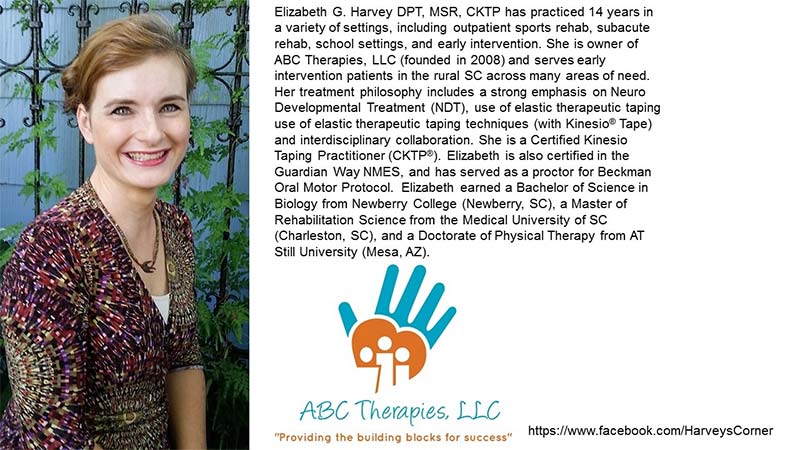
Follow ABC Therapies LLC on their Facebook page or contact via email: abctherapy@homesc.com
*******
Macias-Harris and Harvey shared the following information regarding their newest class:
Sun Seminars is proud to announce our newest class:
“Cognitive Processing, Verbal/Auditory Performance, and Swallowing Progression with Elastic Therapeutic Tape”.
Data assessment collection and taping strategies will be practiced that focus on treatment areas associated with cognition, speech-language-hearing, respiration, and swallowing/feeding deficits.
All disciplines who have completed the approved Kinesio Tape Association (KTA) KT1, KT2 and KT3 courses are welcome to take our newest class!
There is still time to register for the KTA standardized (KT1-KT3) coursework!
Contact Judee Macias-Harris, M.S., CCC-SLP/BSLP/CKTI; 602-999-7998; judith.macias@cox.net for more information!!
*******
References & Resources
Adameyko, I. and Freid, K. (2016). The nervous system orchestrates and integrates craniofacial development: a review. Front Physio, [Online]. 7,49. Available at: http//dx/doi.org/10.3389/fphus.2016.00048[Accessed 28 March 2016]
Allen, C. The official website of Allen Cognitive Levels, https://www.allen-cognitive-levels.com/levels.htm, retreived on 9/21/15.
Alomar, X., Medrano, J., Cabratosa, J., Clavero, J.A., Lorente, M., Sierra, I, Monill, J.M., and Salvador, A. (2007). Anatomy of the Temporomandibular Joint. Semin Ultrasound CT MRI, 28,170-183.
Alvaraz-Buylla, A. and Garcia-Verdugo, J. (2002). Neurogenesis in adult subventricular zone. The Journal of Neuroscience, 22(3), 629-634.
Aman, J. E., Elangovan, N., Yeh, I.-L., & Konczak, J. (2014). The effectiveness of proprioceptive training for improving motor function: a systematic review. Frontiers in Human Neuroscience, 8, 1075. https://doi.org/10.3389/fnhum.2014.01075.
American Speech-Language-Hearing Association. Scope of Practice in Speech-Language Pathology Ad Hoc Committee on the Scope of Practice in Speech-Language Pathology; retrieved January 24, 2015 from https://www.asha.org/uploadedFiles/SP2007-00283.pdf
American Speech-Language-Hearing Association. Scope of Practice in Speech-Language Pathology Ad Hoc Committee on the Scope of Practice in Speech-Language Pathology; retrieved January 24, 2015 from https://www.asha.org/policy/sp2007-00283.htm
Arts-Rodas, D. and Benoit, D. (1998). Feeding Problems in Infancy and Early Childhood: Identification and Management. Paediatrics & Child Health, 3(1) 21–27.
Ash, C.M. and Pinto, O.F. (1991). The TMJ and the middle ear: structural and functional correlates for aural symptoms associated with temporomandibular joint dysfunction. Int J Prosthodont, 4(1), 51-57.
ASTYM, retrieved on February 7, 2015, from https://astym.com/Main.
Author unknown. Digestion in oral cavity. Digestion in stomach, intestine and colon. Absorption and motor function in the gastrointestinal tract. Retreived on May 15, 2016, from https://intranet.tdmu.edu.ua/data/kafedra/internal/normal_phiz/classes_stud/en/stomat/2%20course/5%20Cycle%20Physiology%20of%20digestion%20system%20and%20kidneys/01%20Digestion%20in%20oral%20cavity.%20Digestion%20in%20stomach,%20intestine%20and%20colon.htm
Ayda, A., Nihan, O., Ozgur, S., Gul, B., Pınar, O. and Metin, K. (2011). Initial effects of Kinesio® taping in patients with patellofemoral pain syndrome: A randomized, double-blind study. Isokinetics and Exercise Science, 19, 135-142.
Barnes, Larry. (2011). Effects of NMES on pharyngeal muscle group synergy while swallowing. International Journal of Physical Sciences, 6(24), 5866-5870.
Barerra, M. (2015). The Role of NMES in Dysphagia Management: Clinical Use & Application of The Guardian Way WORKSHOP HK 7-8 MARCH 2015.
Barral, J.P. (2006). Viseral Manipulation Abdomen 1 (VM1) (Book and workbook). Eastland Press, 1 Revised Edition (February, 15, 2006). 214 pgs.
Barsoumian, R., Kuehn, D.P., Moon, J.B., and Canady, J.W. (1998). An anatomic study of the tensor veli palatini and dilatator tubae muscles in relation to Eustachian tube and velar functioning. Cleft Palate Craniofacial Journal, 35(2), 101-10.
Bergland, C. Hand-Eye Coordination Improves Cognitive and Social Skills, https://www.psychologytoday.com/blog/the-athletes-way/201311/hand-eye-coordination-improves-cognitive-and-social-skills, retrieved on 2/19/2016.
Bethune, D. (1994). Another look at neurological rehabilitation. Australian Physiotherapy, 40(4), 255-261.
Blum, Charles L. (2008). The relationship between the pelvis and stomatognathic system: A position statement. Sacro Occipital Technique Organization-USA, 40-43.
Bonaz, B. (2004). Visceral sensitivity perturbation integration in the brain-gut axis in functional digestive disorders. Journal of Physiology and Pharmacology, 55, 27-42.
Boyd-Brewer, C., & McCaffrey, R. (2004). Vibroacoustic sound therapy improves pain management and more. Holistic nursing practice, 18(3), 111-118.
Brain Anatomy, retrieved on 11/16/15, from https://emedicine.medscape.com/article/1898830-overview.
Brainy Quotes May 17, 2016
Brinton, B., & Fujiki, M. (2003). Blending quantitative and qualitative methods in language research and intervention. American Journal of Speech-Language Pathology, 12(2), 165-171.
Buraa, M.F. and Alazawi, H.S., (2013). The relationship among otic clinical findings and temporomandibular joint disorders populations. Iraqui Postgrad Med J, 12(4), 546-550.
Byrd, K.E., Romito, L.M., Dzemidzic, M., Wong, D. Talavange, T.M. (2009). fMRI study of brain activity elcitied by oral parafunctional movements. J. Oral Rehabil, 36(5), 346-361.
Cantu, R.I, and Grodin, A.J. Myofascial Manipulation: theory and clinical application. Aspen Publisher. Gaithersburg, MD. 2001.
Capek, S., Tubbs, R.S., and Spinner, R.J.. (2015). Do cutaneous nerves cross the midline? Clin Anat, 28(1), 96-100.
Cedarmark, R., retrieved on 11/21/2015, from https://app.box.com/s/p24liapfl4ddpgx0ibxkzqgfr1ldtdsj.
Chapman, B., Moynihan, J. (2010) The brain-skin connection: role of physchosocial factors and neuropeptides in the psoriasis. Expert Rev Clin Immunol 5(6):623-627.
Chang, W.-D., Chen, F.-C., Lee, C.-L., Lin, H.-Y., and Lai, P.-T. (2015). Effects of Kinesio Taping versus McConnell Taping for Patellofemoral Pain Syndrome: A Systematic Review and Meta-Analysis. Evidence-Based Complementary and Alternative Medicine : eCAM, 2015, 471208. https://doi.org/10.1155/2015/471208.
Clemente, J. C., Ursell, L. K., Parfrey, L. W., & Knight, R. (2012). The impact of the gut microbiota on human health: an integrative view. Cell,148(6), 1258-1270.
Compensatory Strategy, https://link.springer.com/referenceworkentry/10.1007%2F978-0-387-79948-3_1086, retrieved on 1/11/2015
Coombes, S.A., Cauraugh, J.H., and Janelle, C.M. (2006). Emotion and movement: Activation of defensive circuitry alters the magnitude of a sustained muscle contraction. Neuroscience letters, 396(3), 192-196.
Cornell University. (2016, June 27). Chronic fatigue syndrome is in your gut, not your head. ScienceDaily. Retrieved June 28, 2016 from www.sciencedaily.com/releases/2016/06/160627160939.htm
Davidson, J.A., Metzinger, S.E., Tufaro, A.P., and Dellon, A.L. (2003). Clinical implications of the innervation of the temporomandibular joint. J Craniofac Surg, 14(2), 235-239.
De Carvalho Martins, J., Aguiar, S.S., Nogueira Fabro, E.A., Medeiros Costa, R., Vilela Lemos, T., Gienbinsky Guapyassú de Sá, V., Mello de Abreu, R., Figueiredo Carvalho de Andrade, M., Santos Thuler, L.C., Bergmann, Anke. (2015). Safety and tolerability of Kinesio® Taping in patients with arm lymphedema: medical device clinical study. Supportive Care in Cancer, first online: 14 August 2015. https://link.springer.com/article/10.1007/s00520-015-2874-7?no-access=true#
De Ru, E. (2013). Excerpt pages 158-161 of Elastic therapeutic Taping in Paediatrics December 2013 in Press ISBN 978-90-818888-2-0 Esther de Ru
DeRuiter, C. (2010). Somites: Formation and Role in Developing the Body Plan. The Embryo Project Encyclopedia, 20 Oct. 2010. Web. 15 March 2016. <https://embryo.asu.edu/pages/somites-formation-and-role-developing-body-plan>.
Description of Dry Needling in Clinical Practice: An Educational Resource Paper, retrieved on February 7, 2015, from https://www.aaompt.org/documents/DryNeedlinginPTClinicalPracticeEducationalResourcePaper.pdf.
Dermatomes and Mytomes and its clinical special test in upper limb and lower limbs, retrieveid on June 19, 2016, rom https://www.slideshare.net/TafzzSailo/special-test-for-dermatomes-and-myotomes/12.
Doidge, N. (2015). The brain’s way of healing: Remarkable discoveries and recoveries. Frontiers of Neuroplasticity. Viking Press. ISBN: 9780670025503
Dysphagia Ramblings, “Aspiration Risks”, retrieved on February 15, 2016, from https://dysphagiaramblings.net/2016/02/15/aspiration-risk/.
Dunbar, K.B., Agoston, T., Odze, R.D., Huo, X., Pham, T.H., Cipher, D.J., Castel, D.O., Genta, R.M., Souza, R.F., and Spechler, S.J. (2016). Assocation of acute gastroesophageal reflux disease with esophageal histologic changes. JAMA, 315(19), 2104-2112.
Ernest, E.A. (2010). =Ernest Syndrome and Insertion of the SML at the Mandible. Practical Pain Management, 30 Jan. 2012. Web. 10 May 2016. < https://www.practicalpainmanagement.com/pain/maxillofacial/ernest-syndrome-insertion-sml-mandible >.
Ely, J.W (M.D.), Hansen, M.R. (M.D.), Clark, E.C. (M.D.). 2008. Diagnosis of ear pain. Am Fam Physician, 77(5), 621-628.
Fallgatter, A.J., Neuhauser, B., Herrmann, M.J. (2003) Far field potentials from the brain stem after transcutaneous vagus nerve stimulation. J Neural Transm, (110), 1437–43.
Faught, E. and Tatum, W. (2013). Trigeminal stimulation: A superhighway to the brain? Neurology, 80 (9), 780-781.
Finlay, O. (2014). Oliver Finlay’s Blog. Retrieved April 1, 2015, from https://www.oliverfinlay.com/blog.asp?id=OJF-BC10255
Fisher, Robert S. (2011). Benefits of trigeminal nerve stimulation. Epilepsy & Behavior, 22(4), 615-616.
Flynn, J.E., M.D., (1956). Adduction contracture of the Thumb. N Engl J Med, (254), 677-686.
Gaziano, J.E. (2002). Evaluation and Management of Oropharyngeal Dysphagia in Head and Neck Cancer. Cancer Control, 9(5), 400-409.
Gisel, E.G, Schwartz, S., Petryk, A., Clarke, D., and Haberfellner, H. (2000). “Whole Body” mobility after one year of intraoral appliance therapy in children with cerebral palsy and moderate eating impairment. Dysphagia, 15, 226-235.
Guimberteau J.C. (2007). Strolling Under the Skin. First International Fascia Research Congress. Boston.
Guimberteau, J.C., Delage, J.P, and Wong, J. (2010). The role and mechanical behavior of the connective tissue in tendon sliding. Chirurgie de la Main, 29(3), 155-166.
Guzowski, K., & Knobloch, J. (1963). Disorders of the nervous system: Activity of acid and alkaline phosphatase in the cerebrospinal fluid. Archives of neurology, 8(1), 105-111.
Guzzetta, A., Baldini, S, Bancale, A., Baroncelli, L., Ciucci, F., Ghirri, P., Putiganano, E., Sale, A., Veigi, A. Berardi, N., Boldrini, A., Cioni, G. and Lamberto, M. (2009). Massage accelerates brain development and the maturation of visual function. The Journal of Neuroscience, 29(18), 6042-6051.
Galgut, P.N. (2001). The relevance of pH to gingivitis and perodontis. J Int Acad Periodontol, 3(3), 61-67.
Hamdy, S., Rothwell, J.C., Aziz, Q., Singh, K.D., and Thompson, D.G. (1998) Long-term reorganization of human motor cortex driven by short-term sensory stimulation. Nature Neuroscience, 1(1), 64-68.
https://www.yorkvillept.com/site/about/what-is-a-pt-modality, retrieved on 1/11/2015
https://www.asha.org/Code-of-Ethics; retrieved on 1/11/2015.
Hoke, A. (2011) A (heat) shock to the system promotes peripheral nerve regeneration. J Clin Invest 121(11): 4231–4234.
Hwang, K., Han, J.Y., Chung, J.H, and Hwang, S.H. (2005). Cutaneous sensory branch of the mylohyoid nerve. J Craniofac Surg., 16(3), 343-346.
How to Stop Grinding Your Teeth (Bruxism) | AZ Family Dental. AZ family Dental. N.p., n.d. Web20 May 2016.
(“Images courtesy of Visible Body (www.visiblebody.com)”
Ingber, D.E. (2003). Tensegrity I. Cell structure and hierarchical systems biology. Journal of Cell Science, 116(7), 1157-1173.
Ingber, D.E. (2006). Cellular mechanotransduction: putting all the pieces together again. FASEBJ, 20(7), 811-827.
Jaraczewska, E. and Long, C. (2006). Kinesio® in Stroke: improving functional use of the upper extremity in hemiplegia. Top Stroke Rehabi, 13(3), 31-42.
Johnson, S.R. and Gray, J. (2008). Role of the Jaw. Advanced Healthcare Network for Speech and Hearing, 18(35), 13.
Kafa, N. Prioception: the forgotten 6th sense. OMICS Group Ebooks.2015; 1-13.
Ka Hana ‘Imi Na‘auao – A Science Careers Curriculum Resource, retrieved on May 20, 2016, at https://www.cds.hawaii.edu/kahana/downloads/curriculum/SectionII/Unit5/Unit5Appendix/5.X.B.CellularRespiration.pdf
Kaltenborn, F.M., Evjenth, O., Baldauf, T., Morgan, D., and Vollowitz, E. Manual Mobilization of the Joints: The Kaltenborn Method of Joint Examination and Treatment. Oslo: Olaf Norlis Bokhandel, 1999. Print.
Kase, K., Stockheimer, K., and Schrauth, R. (2013). KT4: Specialty Lymphatic Concepts of the Kiensio Taping® Method. Kinesio IP, LLC.
Kase, K. (2014). K1-K3 Instructor’s Manual. Kinesio IP, LLC.
Kase, K. (2014). EDF™ Method Based on the Concept of Space Movement Cooling. KTAI Instructor Recertification. October, 2015. Albuquerque, NM.
Kase, K., Stockheimer, K.R., and Piller, N. (2006). Kinesio Taping® for Lymphedema and Chronic Swelling.
Kato, I. T., Pellegrini, V. D., Prates, R. A., Ribeiro, M. S., Wetter, N. U., & Sugaya, N. N. (2010). Low-level laser therapy in burning mouth syndrome patients: a pilot study. Photomedicine and Laser Surgery, 28(6), 835-839.
Kaya, E., Murat, Z., and Ilknur, T. (2011). Kinesio taping compared to physical therapy modalities for the treatment of shoulder impingement syndrome. Clinical Rheumatology, 30 (2), 201-207.
Keller, J. T., Saunders, M.C., van Loveren, H., and Shipley, M.T. (1984). Neuroanatomical considerations of palatal muscles: tensor and levator veli palatini. The Cleft Palate Journal, 21(2), 70-75.
Kelly, J. (2011). Myofascial release manual techniques in dysphagia management a course for practicing clinicians. Career Improvement & Advancement Opportunities (CIAO); www.ciaoseminars.com
Kendall, F. P., McCreary, E.K., Geise, P. Provance. Muscles, Testing and Function: With Posture and Pain. Baltimore, MD: Williams & Wilkins, 1993. Print.
Khoo, J., Rickard Liow, S.J., and Yoon, Wai Lam. 2015. Comparison of suprahyoid muscles activity between chin-tuck-against resistance (CTAR) and the Shaker exercises. Poster presentation. Dysphagia Research Society 23rd Annual Meeting at Illinois, Chicago, USA (12-14 March 2015).
Klimas, N. (2003). Oral-Motor Therapy: A Protocol for Speech and Feeding. Advance Healthcare Network, 8 Sept. 2003. Web. 20 Apr. 2016. <https://speech-language-pathology-audiology.advanceweb.com/Article/Oral-Motor-Therapy.aspx>.
Kolb, B. and Whishaw, I. (1990). Fundamentals of Human Neuropsychology. W.H. Freeman and Co., New York.
Kirshblum, S.C., Burns, S.P., Biering-Sorensen, F., Donovan, W., Graves, D.E., Jha, A., Johansen, M., Jones, L., Krassioukov, A., Mulcahey, M.J., Schmidt-Read, M., Waring., W. (2011). International standards for neurological classification of spinal cord injury. (Revised 2011). The Journal of Spinal Cord Medicine, 34(6), 535-546. https://doi.org/10.1179/204577211X13207446293695
Kleim, J.A. and Jones, T.A. (2008). Principles of Experience-Dependant Neural Plasticity: Implications for Rehabilitation After Brain Damage. Journal of Speech Language and Hearing Research, 51(1), 46-51.
Klimas, N. (2016). Oral-Motor Therapy: A Protocol for Speech and Feeding. Oral-Motor Therapy. Advance Healthcare Network, 8 Sept. 2003. Web. 20 Apr. 2016. <https://speech-language-pathology-audiology.advanceweb.com/Article/Oral-Motor-Therapy.aspx>.
Laciuga, H., Rosenbek, J.C., Davenport, P.W., Sapienza, C.M. (2014). Functional outcomes associated with expiroatory muscle strength training: Narrative review. Journal of Rehabilitation Research and Development, 51(4), 535-546.
Ladak, A., Tubbs, R.S., and Spinner, R.J. (2013). Mapping Sensory Nerve Communications between Peripheral Nerve Territories. Clinical Anatomy, 27(5), 681-90.
Lake, D. (1992). Neuromuscular electrical stimulation. Sports Medicine, 13(5), 320-336.
Leder, S.B., Suiter, D. M., and Warner, H. L. (2009). Answering orientation questions and following single-step verbal commands: Effect on aspiration status. Dysphagia, 24(3), 290-295.
Lesher, J. Modalities in Rehab, retrieved on February 3, 2015, from www.usuhs.edu/fap/resources/eit/Modalities inRehab.ppt
Marino, .R.J. and Graves, D.E. (2006). Ten dermatomes are enough! Information in a 10-dermatome ASIA sensory score is comparable to the full (28-dermatome) score. In: 45th Annual Scientific Meeting of the International Spinal Cord Society and 32nd Annual Meeting of the American Spinal Injury Association;June 23-28, 2006; Westin Copley Place Hotel, Boston, MA.
McCabe, D., Ashford, J., Wheeler-Hegland, K., Frymark, T., Mullen, R., Nusson, N., Smith Hammond, C., and Schooling, T., (2009). Evidence-based systematic review: Oropharyngeal dysphagia behavioral treatments. Part IV-Impact of dysphagia treatment on individuals’ post cancer treatments. Journal of Rehabilitation Research & Development, 46(2), 205-2014.
McCulloch, T.M., Hoffman, M.R., Ciucci, M.R. (2010). High resolution manometry of pharyngeal swallow pressure events associated with head turn and chin tuck. Ann Otol Rhinol Laryngol. 119(6), 369–376.
McGough, J. J., Loo, S. K., Sturm, A., Cowen, J., Leuchter, A. F., & Cook, I. A. (2015). An eight-week, open-trial, pilot feasibility study of trigeminal nerve stimulation in youth with attention-deficit/hyperactivity disorder. Brain stimulation, 8(2), 299-304.
Macias-Harris, J. (2015) Epidermis, Dermis, and Fascia (E D F TM Taping) for Cranial Nerve 5 (CN5V3) on the mandible. Poster presentation. 2015 Kinesio Taping Association International Research Symposium to be held November 21-23, 2015. Tokyo, Japan.
Macias-Harris, J. and Goo, J. (2015). Elastic therapeutic taping as an adjunct modality for the SLP. Presenter. The First International Course- Elastic taping techniques for the Speech Pathologist. March 28-29, 2015, Century Paulista Flat, Sao Paolo, Brazil.
Macias-Harris, J. and Harvey, E. (2016). Cognitive processing, swallowing progression, and verbal and auditory performance with Kinesio Tape® Fundamentals and Whole Body Taping. Co-presenters. In progress
Macias-Harris, J. and Hernandez-McManus, M. (2014). Expanding the “SLP Toolbox”- postural rehabilitation in dysphagia management using Kinesio® Tape, excerpt from full article entitled, “DysPhagia-Postural Compliance, Highlighting the “P” in dysphagia management practices”, Advanced Healing, Summer2014, 23.
Magee, D. J. Orthopedic Physical Assessment. Philadelphia, PA: W.B. Saunders, 1997. Print
Marek, W., Muckenhoff, K., Prabhakar, N.R., (2008). Significance of pulmonary vagal afferents for respiratory muscle activity in the cat. Journal of Physiology and Pharmacology, 59(6), 407-420.
Mazoyer, B., Zago, L., Mellet, E., Bricogne, S., Etard, O., Houde, O., and Tzourio-Mazoyer, N. (2001). Cortical networks for working memory and executive functions sustain the conscious resting state in man. Brain research bulletin, 54(3), 287-298.
Mei, R.J., Xu, Y.Y., Li, Q. (2010) Experimental study on mechanical vibration massage for treatment of brachial plexus injury in rats. J Tradit Chin Med 30(3): 190-95.
Melzack, R. (2005). Evolution of the neuromatrix theory of pain. The Prithvi Raj Lecture: presented at the third World Congress of World Institute of Pain, Barcelona 2004. Pain Pract 5(2), 85-94.
Melzack, R., & Wall, P. D. (1967). Pain mechanisms: a new theory. Survey of Anesthesiology, 11(2), 89-90.
Miller, W.L. and Crabtree, B.F. (1994). Clinical research. In N. K. Denzin & Y. S. Lincoln (Eds.), Handbook of qualitative research (pp. 340–352). Thousand Oaks, CA: Sage.
Milner, B. (1968). Visual recognition and recall after right temporal lobe excision in man. Neuropsychologia, 6, 191-209.
Moon, H. J., & Lee, Y. K. (2011). The relationship between dental occlusion/temporomandibular joint status and general body health: Part 2. Fascial connection of TMJ with other parts of the body. The Journal of Alternative and Complementary Medicine, 17(12), 1119-1124.
Mori, A., and Takasaki, M. (2010). Activation of cerebral cortex in various regions after using Kinesio tape, https://www.kinesiotaping.com/images/kinesio-association/pdf/research/2005-9.pdf, retrieved on 5/18/14.
Neely, J.G., Cherian, N.G., Dickerson, C.B., Nedzelski, J.M. (2010). Sunnybrook facial grading system: reliabity and criteria for grading. Laryngoscope, 120(5), 1038-1045.
Neuromuscular Electrical Stimulation (NMES), retrieved on February 7, 2015, from, https://www.bcbsms.com/com/bcbsms/apps/PolicySearch/views/ViewPolicy.php?&noprint=yes&path=/policy/emed/Neuromuscular_Stimulator.html
Norkin, C. & Levangie, P. (1992). Joint structure & Function: A comprehensive analysis. Philadelphia, PA: F.A. Davis Company.
Overview: Functions of the Cerebellum, https://neuroscience.uth.tmc.edu/s3/chapter05.html, retrieved on 2/21/16.
Ohm, B.M., Dae-Yul, K., and Nam-Jong. P. (2007). Recovery of swallowing function is accompanied by the expansion of the cortical map. International Journal of Neuroscience, 117 (9), 1215-1227.
Palomares, K. T. S., Gleason, R. E., Mason, Z. D., Cullinane, D. M., Einhorn, T. A., Gerstenfeld, L. C., & Morgan, E. F. (2009). Mechanical stimulation alters tissue differentiation and molecular expression during bone healing. Journal of Orthopaedic Research, 27(9), 1123-1132.
Pearson, W. G., Hindson, D. F., Langmore, S. E., & Zumwalt, A. C. (2013). Evaluating swallowing muscles essential for hyolaryngeal elevation by using muscle functional magnetic resonance imaging. International Journal of Radiation Oncology* Biology* Physics, 85(3), 735-740.
Pilla, A.A., (1999). State of the art in electromagnetic therapeutics: Soft tissue applications. Electricity and Magnetism in Biology and Medicine, F. Bernsani, ed., Plenun, NY. 871-874.
Pollock, A.S., Durward, B.R., Rowe, P.J., and Paul JP. (2000). What is balance? Clin Rehabil., 14(4), 402-6.
PureHealthMD. Physical Therapy Modalities, retrieved on February 7, 2015, from https://health.howstuffworks.com/medicine/tests-treatment/physical-therapy-modalities.htm.
Purves D., Augustine, G.J., and Fitzpatrick, D. (2001). Mechanoreceptors Specialized to Receive Tactile Information. Neuroscience 2nd Edition, 2001. Web. 25 Apr. 2016. < https://www.ncbi.nlm.nih.gov/books/NBK10895/>.
Read, D. (1981). Solving deductive-reasoning problems after unilateral temporal lobectomy. Brain and Language, 12, 116-127.
Redstone, F. and West, J.F. (2004). The importance of postural control for feeding. Pediatric Nursing, 30(2), 97-100.
Ristow, O., Hohlweg-Majert, B., Stürzenbaum, S.R., Kehl, V., Koerdt, S., Hahefeld, L., and Puutke, C. (2014). Therapeutic elastic tape reduces morbidity after wisdom teeth removal- a clinical trial. Clinical Oral Investigations, 18(2), 1205-1212.
Rubik, B. (2002). The Biofield Hypothesis: Its biophysical basis and role in medicine. The Journal of Alternative and Complementary Medicine, 8(6),703-717.
Samuels, E. R., & Szabadi, E. (2008). Functional Neuroanatomy of the Noradrenergic Locus Coeruleus: It’s Roles in the Regulation of Arousal and Autonomic Function Part I: Principles of Functional Organisation. Current Neuropharmacology, 6(3), 235–253. doi:10.2174/157015908785777229
Sandelowski, M. (2000). Focus on research methods combining qualitative and quantitative sampling, data collection, and analysis techniques. Research in Nursing & Health, 23, 246-255.
Schönmeyr, B. and Sadhu, P. (2014). A review of the tensor veli palatine function and its relevance to platoplasty. Journal of Plastic Surgery and Hand Surgery, 48(1), 5-9.
Sanders, R. D. (2010). The Trigeminal (V) and Facial (VII) Cranial Nerves: Head and Face Sensation and Movement. Psychiatry (Edgmont), 7(1), 13–16.
Schrader, L.M., Cook, I.A., Miller, P.R., Maremont, E.R., DeGiorgio, C.M. (2011). Trigeminal nerve stimulation in major depressive disorder: First proof of concept in an open pilot trial. Epilepsy & Behavior, 22(3), 475-478.
Shaw, G. Y., Sechtem, P. R., Searl, J., Keller, K., Rawi, T. A., & Dowdy, E. (2007). Transcutaneous neuromuscular electrical stimulation (VitalStim) curative therapy for severe dysphagia: myth or reality? Annals of Otology, Rhinology & Laryngology, 116(1), 36-44.
Simmonds, N., Miller, P., and Gemmel, H. (2012). Theoretical framework for the role of fascia in manual therapy. J Bodyw Mov Ther., 16(1), 83–93.
Skille, O. (1989). VibroAcoustic therapy. Music Therapy, 8(1), 61-77.
Smith, S.K., Roddam, H., and Sheldrick, H. (2012). Rehabilitation or compensation: Time for a fresh perspective on speech and language therapy or dysphagia and Parkinson’s disease? International Journal of Language & Communication Disorders, 47(4), 351-364.
Stiles, M. (2000). Structural Yoga Therapy: Adapting to the Individual. Weiser Books. 123 pages.
Spencer, J. (2015). Lecture. Clinical Mastery of the Low Level Laser. Marriott Downtown Scottsdate. Scottsdale, AZ. September 12-13, 2015.
Suntrup, S., Teismann, I., Wollbrink, A., Winkels, M., Warnecke, T., Pantev, C., and Dziewas, R. (2015). Pharyngeal electrical stimulation can modulate swallowing in cortical processing and behavior — Magnetoencephalographic evidence. Neuroimage 104, 117+. Academic OneFile. Web. 3 Feb. 2015.
Swenson, R., Catlin, B., and Lyons, J. (2008). The Hand. Basic Human Anatomy, 2008. Web. < https://www.dartmouth.edu/~humananatomy/part_2/chapter_11.html>.
Transcutaneous Electrical Nerve Stimulation (TENS) – Topic Overview, retrieved on February 7, 2015, from https://www.webmd.com/pain-management/tc/transcutaneous-electrical-nerve-stimulation-tens-topic-overview.
Tribucci, A., T., Penedo-Leme, S., and Rodrigues Funayama, C.A. (2009). Postural Adjustment as a Sign of Attention in 7-month-old Infants. Brain and Development, 31(4), 300-06.
Turgut, E. and Duzgun, I. Shoulder Problems and Proprioception. Proprioception: The Forgotten Sixth Sense. By OMICS Group EBooks, Foster City, CA. 1-15. Print
Tsuchitani, C. and Dougherty, P. Somatosensory Processes.”Neuroscience Online UTHealth, 2011?? Web 5 May 2016. <https://neuroscience.uth.tmc.edu/s2/chapter05.html>.
Uluç Pamuk, Can A., and Yucesoy N. (2015). MRI analyses show that kinesio taping affects much more than just the targeted superficial tissues and causes heterogeneous deformations within the whole limb. Journal of Biomechanics, 48(16), 4262 – 4270.
Urbanowicz, M., (1991). Alteration of vertical dimension & its effect on head & neck posture. J Craneomandibular Practice, 9(2), 174-179.
Van den Berg, J. W., Zantema, J. T., & Doornenbal Jr, P. (1957). On the air resistance and the Bernoulli effect of the human larynx. The Journal of the Acoustical Society of America, 29(5), 626-631.
Ventureyra E.C.G. (2000). Transcutaneous vagus nerve stimulation for partial onset seizure therapy: a new concept. Childs Nerv Syst, (16), 101–102.
Verma, A. Trigeminal Nerve (Mandibular Division), retrieved on February 17, 2015, from https://www.slideshare.net/DrAviral/trigeminal-nerve-mandibular-division-introduction.
Viljanen, A., Kaprio, J., Pyykkö, I., Sorri, M., Pajala, S., Kauppinen, M., Kosekenvo, M., and Rantanen, T. (2009). Hearing as a predictor of falls and postural balance in older female twins. The Journals of Gerontology Series A: Biological Sciences and Medical Sciences, 64(2), 312-317.
Wen, Z., Zeng, W., Dai, J., Zhou, X., Yang, C., Duan, F., Liu, Y., Yang, H., and Yuan, L. (2012). Paravertebral fascial massage promotes brain development of neonatal rats via the insulin-like growth factor 1 pathway. Neural Regen Res, 7(15), 1185-1191.
What is a PT modality?, retrieved January 24, 2015, from https://www.yorkvillept.com/site/about/what-is-a-pt-modality.
Wheeler. K.M. and Sapienza, C. S., (2005). Swallowing and Respiration: Shared Neural Substrates, retrieved on May 15, 2016, from https://www.speechpathology.com/articles/swallowing-and-respiration-shared-neural-1255.
Wigram, A. L. (1996). The effects of vibroacoustic therapy on clinical and non-clinical populations (Doctoral dissertation, University of London).
Wijting, Y. and Freed, M. (2011). VitalStim® Therapy: VitalStim Certification Program (Provided by CIAO Seminars), Training Manual for the use of Neuromuscular Electrical Stimulation in the treatment of Dysphagia, vitalstimtherapy.com; ciaoseminars.com.
Williams, D. Concussions in Sports and a Preventable Mechanism, retrieved on March 12, 2015, from www.mosessport.com/Concussions_in_Sports__and_a_Preventable_Mechanism_of_Injury.pdf
Wilke, J., Krause, F., Vogt, L., Banzer, W. (2015). What is evidence-based about myofascial chains? A systematic review. Arch Phys Med Rehabil, Received: July 22, 2015; Received in revised form: July 28, 2015; Accepted: July 29, 2015; Published Online: August 14, 2015.
Yasukawa, A., Patel, P., and Sisung, C. (2006). Pilot study: investigating the effects of Kinesio Taping in an acute pediatric rehabilitation setting. Am J Occup Ther., 60(1), 104-110.
Zhang, Y., Hoon, M. A., Chandrashekar, J., Mueller, K. L., Cook, B., Wu, D., & Ryba, N. J. (2003). Coding of sweet, bitter, and umami tastes: different receptor cells sharing similar signaling pathways. Cell, 112(3), 293-301.


